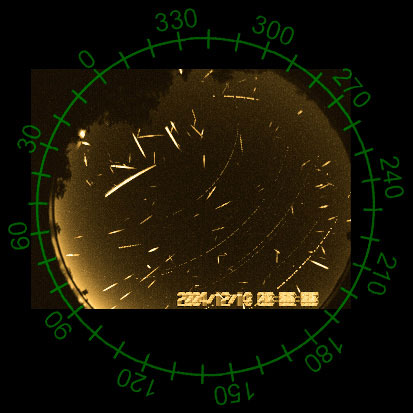| Dec 12, 2012 |
Geminid meteors set to light up winter sky
|
|
(Nanowerk News) On the evening of 13 and the morning of 14 December, skywatchers across the world will be looking up as the Geminid meteor shower reaches its peak, in potentially one of the best night sky events of the year.
|
|
At its peak and in a clear, dark sky tens of ‘shooting stars’ or meteors may be visible each hour. Meteors are the result of small particles entering the Earth’s atmosphere at high speed, burning up and super-heating the air around them, which then shines as a characteristic short-lived streak of light. In this case the debris is associated with the asteroidal object 3200 Phaethon, which many astronomers believe to be an extinct comet.
|
 |
| An all-sky image of the 2004 Geminids meteor shower. (Image: Chris L. Peterson, Cloudbait Observatory)
|
|
The meteors appear to originate from a ‘radiant’ in the constellation of Gemini, hence the name Geminid. By 0200 GMT on 14 December the radiant will be almost overhead from the UK, making it ideally placed for observers. As a bonus, the Moon will not be present in the sky on the morning of maximum activity so the prospects for a good view of the shower are excellent. And unlike many astronomical phenomena, meteors are best seen without a telescope (and are also perfectly safe to watch).
|
|
Meteors in the Geminid shower are less well known than those at other times of year, probably because the weather in December is less reliable. But those who brave the cold can be rewarded with a fine view. In comparison with other showers, Geminid meteors travel fairly slowly, at around 35 km (22 miles) per second, are bright and have a yellowish hue, making them distinct and easy to spot.
|
|
According to the International Meteor Organisation, which coordinates meteor observations, the Geminids meteor shower will peak at around 2330 GMT on 13 December, but the highest level activity is spread over a period lasting a day or more. This means that if conditions are clear even casual observers may want to take a look until Saturday morning.
|

